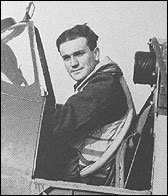‘Paddy of the RAF’
Published in Blogging Irish HistoryFollowing on from the article we recently dug out of the back-catalogue on ‘Wrong Way Corrigan’ (Sept/Oct 2008), we’re sticking with the aviation theme. Viewers of the recent RTÉ documentary ‘Pioneers and aviators’ may have felt that it left a few things out; Corrigan didn’t make the cut. But neither did an unusual example of an Irish aviator: Brendan Finucane, a Dubliner and graduate of O’Connell Schools whose family moved to Richmond in London in the 1930s. Subsequently, Finucane joined the RAF, as did his younger brother, who became a gunner in Bomber Command. Perhaps ironically, their father had fought at Boland’s Mills under Eamon de Valera during the Easter Rising; he was apparently amused at the contradiction between his own background and the path followed by his sons, but took the view that Ireland should not have stayed neutral, given that Germany was unlikely to spare it from invasion.
Brendan Finucane (also known by the rather unoriginal sobriquet of ‘Paddy’) was born in Rathmines in 1920, and was the subject of a notable profile by A.J. Liebling, published in The New Yorker on 6 December 1941: the day before the Japanese attack on Pearl Harbour (his early life in Dublin is explored through the reminiscences of his surviving family in this RTÉ Radio documentary from 2004).
In the RAF, Finucane became a remarkably successful fighter pilot in the Battle of Britain. By the time The New Yorker published its profile, Finucane had shot down at least 23 German planes and had been decorated a number of times. According to Liebling, Finucane, ‘a vocally patriotic Dubliner’, was ‘neither Ulster Irish nor Anglo-Irish nor public-school-and-Oxford denatured Irish but middle-class Dublin Irish, and so proud of it he has a big shamrock painted on his Spitfire…being an RAF officer, he does not go in for political arguments, he explains, but occasionally somebody says something about Éire (sic) which displays a lack of understanding, and then Paddy puts him right’.
Prior to his death over the English Channel in July 1942, he was one of the most successful pilots in the RAF and had risen to the rank of wing commander. Widely lauded in the British press during the Second World War, Finucane is one of 20,000 RAF casualties of that conflict whose bodies were never found, and who are commemorated on the Commonwealth War Grave Commission’s Air Forces Memorial at Runnymede.
The New Yorker profile is reproduced in John Horgan’s recent anthology Great Irish Reportage, which also reproduces a rather interesting interview between Sir John Maffey, the British representative, and Eamon de Valera on the outbreak of the Second World War in September 1939, in which Maffey noted De Valera’s ‘pro-British attitude’, not to mention his ‘bias in our favour’ (you can read the full version here). Just because the centenary of the First World War will be in the limelight in 2014 – and we will be doing our bit in that regard – doesn’t mean that the complex and messy reality of the Irish involvement in the later world war should be neglected.
‘Pioneers and aviators’ will be reviewed in the May/June issue of History Ireland. The July/August issue will be a special edition dedicated to the outbreak of the First World War. John Horgan (ed), Great Irish Reportage (Penguin, 464pp, €22.50hb, ISBN 9781844883219) is available now.
John Gibney

















